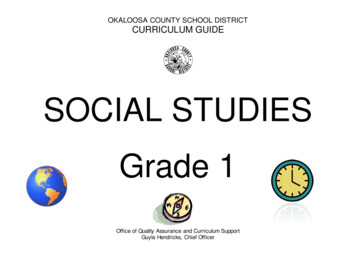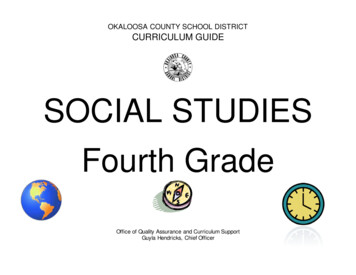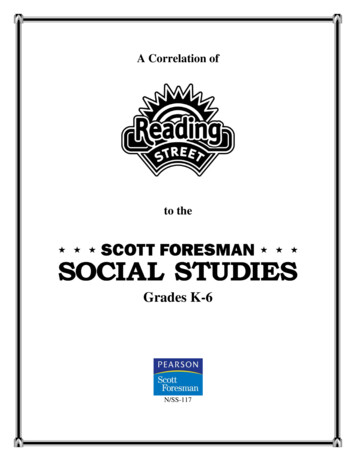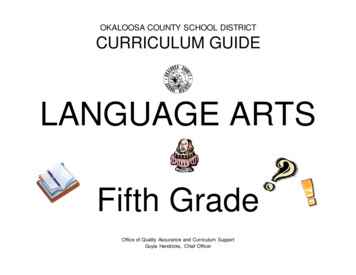
Transcription
OKALOOSA COUNTY SCHOOL DISTRICTCURRICULUM GUIDESOCIAL STUDIESGrade 1Office of Quality Assurance and Curriculum SupportGuyla Hendricks, Chief Officer
Okaloosa County School DistrictCurriculum Guide for Social StudiesCONTENTSMission Statement . 3Suggestions for Implementing Curriculum Guides . 3Florida Department of Education Essential Website. 3OCSD Curriculum and Pacing Guide Overview . 4Quarterly Benchmarks . 5Reading Standards for Informational Text K–5 . 7Grade-level Curriculum Guide . 8Year-long Benchmarks . 8Quarter 1 . 10Quarter 2 . 15Quarter 3 . 19Quarter 4 . 24Reading Rainbow Selections Elementary Social Studies. 30Topic Requirements by Statute . 31Social Studies K-5 Websites and Resources . 32Additional Resources That Encompass All Units . 33Additional Literature by Theme . 34REV 062012First Grade Social StudiesPage 2
Okaloosa County School DistrictCurriculum Guide for Social StudiesMission StatementOkaloosa County teachers are committed to the teaching of social studies in accordance with the highest state and national st andards. We endorse the position ofthe Florida Council for the Social Studies, which states “Florida’s public schools have the responsibility for creating an informed and active citizenry. This goalrequires our students to receive a firm foundation in each of the four major areas represented in the Sunshine State Standards for social studies-history,government/civics, economics, and geography.” We further recognize that our students must learn a bout our nation’s heritage and possess essential economic,civic, geographic, and historical knowledge to equip them for their future responsibilities as citizens of Florida and the United States of America.Suggestions for Implementing Curriculum GuidesThe role of the teacher is to: Teach students the Next Generation Standards as dictated by state law for their grade level. Provide learning-rich classroom activities that teach the benchmarks in depth. Enhance the curriculum by using resources and instructional technology. Differentiate instruction by varying methods of instruction and assessment. Regularly administer assessments to include higher-level questions and performance tasks.In addition, teachers should: Collaborate with other grade-level teachers to maximize school resources and teacher expertise. Consult with other grade-levels to define absolute skill goals for each grade level. Document questions and suggestions for improvement of the Curriculum Guide. Integrate Social Studies with the Reading curriculum. Consider applying for a grant to support project-based learning for their school.Teachers may substitute a reading selection of their choice in lieu of one listed in the quarterly description if the selection aligns to thesame set of benchmarks.Florida Department of Education Essential LStandardSearch.aspxREV 062012First Grade Social StudiesPage 3
Okaloosa County School DistrictCurriculum Guide for Social StudiesOCSD Curriculum and Pacing Guide OverviewThis document provides a Social Studies curriculum and pacing guide. It is designed to help teachers efficiently pace the delivery of qualityinstruction for each nine-week period.(Purpose: This guide was created by a team of grade-level teachers to correlate to the Next Generation Standards with the goal of providingteachers ready access to resources for teaching those new standards and a pace for accomplishing benchmark mastery.Description:The OCSD Social Studies Curriculum Guide specifies the social studies content to be covered within each nine-week instructional period. Theirguide identifies Next Generation Standards (NGS) Benchmarks. Furthermore, it allows teachers to input information specific to their students orschool needs. Top Block – Strand, Standard, Essential Questions, Vocabulary, Primary Literature, Activities Related to Primary Literature Column One – BenchmarkLists the specific Benchmark by number and states the Benchmark. Column Two – Text Alignment, Additional Resources/ActivitiesCites the School Education Group (McGraw-Hill) textbook chapters or pages that correlate to the Benchmark.Suggests instructional activities and materials to supplement the text and primary literature. Column Three – Supplemental LiteratureLists additional literature to extend learning. Column Four – Open: Specific to teacher, grade, subject, schoolServes as a placeholder for teachers to add information that is specific to their school’s or students’ needs.Of note: Benchmarks drive instructional decisions; the text is a resource. Results of assessment are used to adjust and revise instruction.REV 062012First Grade Social StudiesPage 4
Okaloosa County School DistrictCurriculum Guide for Social StudiesQuarterly BenchmarksThe following two standards are taught across the curriculum all year long.Historical Inquiry and AnalysisSS.1.A.1.1 Develop an understanding of a primary sourceSS.1.A.1.2 Understand how to use the media center/other sources to find answers to questions about a historical topicChronological ThinkingSS.1.A.3.1 Use terms related to time to sequentially order events that have occurred in school, home, or communitySS.1.A.3.2 Create a timeline based on the student's life or school events, using primary sourcesQuarter 1 / Textbook Unit 4: Good CitizensQuarter 2 / Textbook Unit 1: People and TraditionsFoundations of Government, Law, and the American Political SystemSS.1.C.1.1 Explain the purpose of rules and laws in the school and community.*SS.1.C.1.2 Give examples of people who have the power and authority to make andenforce rules and laws in the school and community.SS.1.C.1.3 Give examples of the use of power without authority in the school andcommunity.Civics and Political ParticipationSS.1.C.2.1 Explain the rights and responsibilities students have in the schoolcommunity.*SS.1.C.2.2 Describe the characteristics of responsible citizenship in the schoolcommunity.SS.1.C.2.3 Identify ways students can participate in the betterment of their school andcommunity.Historical KnowledgeSS.1.A.2.1 Understand history tells the story of people and events of other times andplaces.SS.1.A.2.2 Compare life now with life in the past.SS.1.A.2.3 Identify celebrations and national holidays as a way of remembering andhonoring the heroism and achievements of the people, events, and ournation's ethnic heritage .SS.1.A.2.4 Identify people from the past who have shown character ideals andprinciples including honesty, courage, and responsibility.SS.1.A.2.5 Distinguish between historical fact and fiction using various materials.Common Core StandardsSee page 7—Reading Standards for Informational Text K-5Common Core StandardsSee page 7—Reading Standards for Informational Text K-5Holidays occurring during this quarter: Labor DayTopic requirements: Conservation of natural resources, alcohol/narcotics effects onbody, kindness to animals.Holidays occurring this quarter: Columbus Day, Veterans Day, ThanksgivingTopic requirements: Patriotism and sacrifices of veterans, flag education, contributionsof women, Hispanics, and African Americans.Suggested Reading SelectionsOffice Buckle and GloriaChester Racoon and the Big Bad BullyMiss RumphiusRainbow FishJohnny AppleseedSuggested Reading SelectionsMy First Little House SeriesSquanto’s Journey: The Story of the First Thanksgiving* Indicates a civics benchmarkREV 062012First Grade Social StudiesPage 5
Okaloosa County School DistrictCurriculum Guide for Social StudiesQuarter 4 / Units 2 and 3: Where We Live and BeginningEconomicsQuarter 3 / Textbook Unit 4: Good CitizensStructure and Functions of GovernmentSS.1.C.3.1 Explain how decisions can be made or how conflicts might be resolved infair and just ways.SS.1.C.3.2 Recognize symbols and individuals that represent American constitutionaldemocracy.*Historical KnowledgeFamous Americans and Black HistorySS.1.A.2.1 Understand history tells the story of people and events of other times andplaces.SS.1.A.2.2 Compare life now with life in the past.SS.1.A.2.3 Identify celebrations and national holidays as a way of remembering andhonoring the heroism and achievements of the people, events, and ournation’s ethnic heritage.SS.1.A.2.4 Identify people from the past who have shown character ideals andprinciples including honesty, courage, and responsibility.*SS.1.A.2.5 Distinguish between historical fact and fiction using various materials.Holidays occurring during this quarter: Martin Luther King Jr. Day, President’s DayTopic requirements: Flag education, Contributions of women, Hispanics, and AfricanAmericans.The World in Spatial TermsSS.1.G.1.1 Use physical and political/cultural maps to locate places in Florida.SS.1.G.1.2 Identify key elements (compass rose, cardinal directions, title, key/legendwith symbols) of maps and globes.SS.1.G.1.3 Construct a basic map using key elements including cardinal directionsand map symbols.SS.1.G.1.4 Identify a variety of physical features using a map and globe.SS.1.G.1.5 Locate on maps and globes the student's local community, Florida, theAtlantic Ocean, and the Gulf of Mexico.SS.1.G.1.6 Describe how location, weather, and physical environment affect the waypeople live in our community .Beginning EconomicsSS.1.E.1.1 Recognize that money is a method of exchanging goods and services .SS.1.E.1.2 Define opportunity costs as giving up one thing for another.SS.1.E.1.3 Distinguish between examples of goods and services.SS.1.E.1.4 Distinguish people as buyers, sellers, and producers of goods andservices.SS.1.E.1.5 Recognize the importance of saving money for future purchases.SS.1.E.1.6 Identify that people need to make choices because of scarce resources.Topic requirements: Health requirements.Common Core StandardsSee page 7—Reading Standards for Informational Text K-5Common Core StandardsSee page 7—Reading Standards for Informational Text K-5Suggested Reading SelectionsDuck for PresidentA is for AmericaSuggested Reading SelectionsMapping Penny’s WorldA Chair for my MotherSomething Good* Indicates a civics benchmarkREV 062012First Grade Social StudiesPage 6
Okaloosa County School DistrictCurriculum Guide for Social StudiesReading Standards for Informational Text K–5Grade 1 Students1. Ask and answer questions about key details in a text.Key Ideas and Details2. Identify the main topic and retell key details of a text.3. Describe the connection between two individuals, events, ideas, or pieces of information in a text.4. Ask and answer questions to help determine of clarify the meaning of words and phrases in a text.Craft and Structure5. Know and use various text features (e.g., headings, tables of contexts, glossaries, electronic menus, icons) tolocate key facts or information in a text.6. Distinguish between information provided by pictures or other illustrations and information provided by words in atext.7. Use the illustrations and details in a text to describe its key ideas.Integration of Knowledge andIdeasRange of Reading and Levelof Text Complexity8. Identify the reasons an authors gives to support points in a text.9. Identify basic similarities in and differences between two texts on the same topic (e.g., in illustrations, descriptions,or procedures).10. With prompting and support, read informational texts appropriately complex for grade 1.Standard 10, “Range, Quality and Complexity of Text,” will be implemented through all grades K-12 withprofessional development offered across the school year to support this standard .REV 062012First Grade Social StudiesPage 7
OKALOOSA COUNTY SCHOOL DISTRICTCurriculum Guide for Social StudiesGrade-level Curriculum GuideYear-long BenchmarksSTRAND: American HistorySTANDARD: Historical Inquiry and AnalysisEssential Question: Where can I go to find information about events from long ago?This is an ongoing skill throughout the social studies curriculum.Benchm arkSS.1.A.1.1Develop anunderstanding of aprimary source.Text Alignm entAdditional Resources/ActivitiesSupplem ental LiteratureOpen: Specific to teacher, grade,subject, schoolClassify primary and non primary sourcesDescribe characteristics of a primary sourceBook! Book! Book! by Deborah BrussFarm animals visit a library to check outbooks.Create a journalEQ: What is a primarysource?Library Lion by Michelle KnudsenA library learns the rules of the library.Media center scavenger huntSS.1.A.1.2Understand how to usethe media center/othersources to find answersto questions about ahistorical topic.Textbook: Unit 1 lesson 1, pages 10 -21EQ: Where can I findinformation?REV 062012First Grade Social StudiesPage 8
OKALOOSA COUNTY SCHOOL DISTRICTCurriculum Guide for Social StudiesSTRAND: American HistorySTANDARD: Chronological ThinkingEssential Question: How can you retell events from the past using words and pictures?This is an ongoing skill throughout the social studies curriculum.Benchm arkSS.1.A.3.1Use terms related totime to sequentiallyorder events that haveoccurred in school,home, or community.EQ: How can you retellan event?SS.1.A.3.2Create a timeline basedon the student’s life orschool events, usingprimary sources.EQ: How can youcreate a timeline to giveinformation?Text Alignm entAdditional Resources/ActivitiesSupplem ental LiteratureTextbook:Unit 1 lesson 1, pages 10 – 23.Seven Blind Mice by Ed YoungEach day of the week a mouse goes toexplore a new creatureEveryday Counts Calendar MathUse sequential vocabulary throughout the day:morning, afternoon, evening, night, day, month, year,season, and all their names: yesterday, today,tomorrow, next week/month/year, last week/month/yearfirst, next, then, last, before, after.Textbook:Unit 1 lesson 1, pages 22 - 23Create timelines of: Day in class The child’s life A storyOpen: Specific to teacher, grade,subject, schoolJasper’s Beanstalk by Nick Butterworth(old reading series)Each day Jasper works in his garden.When the Relatives Came by CynthiaRylantA summer vacation is retold.Knots on a Counting Rope by Bill Martin,Jr. (The story of a boy’s birth and earlylife is retold.)My Day/Mi Dia by Rebecca EmberleyMy Life by Paul PistoneScholastic Leveled Reader JCookie’s Week by Cindy WardScholastic Leveled Reader FREV 062012First Grade Social StudiesPage 9
OKALOOSA COUNTY SCHOOL DISTRICTCurriculum Guide for Social StudiesQuarter 1STRAND: Civics and GovernmentSTANDARD: Foundations of Government, Law, and the American Political SystemEssential Question: Why are rules and laws important?Pacing: 3 WeeksVocabulary: citizen, right, rule, law, conflict, symbol, responsibility, belongPrimary Literature: Officer Buckle and Gloria by Peggy Rathmann (Penguin Group Publishing)Officer Buckle teaches safety rules in school.Activities correlating to Officer Buckle and Gloria: Invite resource officer/law enforcement officer to visit classroom. In small groups, provide places (playground, classroom, lunchroom, etc.) for children to make rules and explain why they are important . Role-play examples/non-examples of following rules, how to handle bullying situations. Cause/Effect: Given a set of rules what would be the effect of breaking those rules . Create safety posters to hang in the school. Create a Venn Diagram comparing/contrasting home and school rules. Write a story about a child who does not follow a rule. Write a letter to Officer Buckle. Create a list of times it is important to stick with your buddy (ex: hiking, swimming, etc.).Activities correlating to Chester Raccoon and the Big Bad Bully Create an anchor chart “What is a bully.” Introduce vocabulary: bully, confidence, fear. Role-playing scenarios, put these scenarios on index cards and have children act out and discuss solutions, using vocabulary (e.g., cutting in line,name calling, taking a classmate’s seat, hitting someone, taking other people’s belongings). Share a treasure. (Children may bring in a treasure such as pictures, birthday candles, seashells, ticket stub from ball games; all treasures should besmall enough to fit in a backpack and not be expensive.) Write about the treasure. (After sharing stories, discuss how a friend reacts to the treasure/how would a bully?) Discuss how the badger changes from the beginning of the story to the end. Find examples from the text when the Badger was a bully. Predict how he will react differently once he gained confidence.REV 062012First Grade Social StudiesPage 10
OKALOOSA COUNTY SCHOOL DISTRICTCurriculum Guide for Social StudiesBenchm arkSS.1.C.1.1Explain the purpose ofrules and laws in theschool and community.Text Alignm entAdditional Resources/ActivitiesSupplem ental LiteratureTextbook:Unit 4 Lesson 1. Pages 114 - 121CCSR1.4 onsibilityBelongEQ: Why do we haverules and laws? Whatdoes it mean to be agood citizen?SS.1.C.1.2Give examples ofpeople who have thepower and authority tomake and enforce rulesand laws in the schooland community.Textbook:Unit 4, Lesson 2, Pages 122 - 127EQ: Who makes therules and laws? Howcan people’s actionsaffect others?SS.1.C.1.3Give examples of theuse of power withoutauthority in the schooland community.Open: Specific to teacher, grade,subject, schoolBerenstain Bears and the Bully byBerentstainTextbook:Unit 4 lesson 2, pages 122 - 125Stand Tall, Molly Lou Melon by PattyLovell (A short girl learns that she isspecial even though others make fun ofher.)EQ: What wouldhappen if we didn’thave rules and laws?REV 062012First Grade Social StudiesPage 11
OKALOOSA COUNTY SCHOOL DISTRICTCurriculum Guide for Social StudiesSTRAND: Civics and GovernmentSTANDARD: Civic and Political ParticipationEssential Question: How can I be a good citizen?Pacing: 6 WeeksVocabulary: rights, responsibilities, community, citizen, citizenship, rule, lawPrimary Literature: Miss Rumphius by Barbara Cooney (The Viking Press)Miss Rumphius follows a girl from childhood to old age. She wishes to travel the world (where we meet people living very differently from our lifestyle), thenretire by the sea. But she remembers her grandfather’s advice: you must also do something to make the world more beautiful. When she finally decideswhat that will be, it is a joy for all around her.Activities correlating to Miss Rumphius: Describe Miss Rumphius. What character traits does she possess? Make a Venn Diagram comparing/contrasting her with a character from anotherstory or real life. What traits do you share with Miss Rumphius? Die-cut flowers, put names of children on flowers, students pick a flower and write good character traits about that person. Brainstorm/list ways to better your school community. Create a list of ways Miss Rumphius betters the community. List character traits describing Miss Rumphius . Discuss the character trait of the week/month. Station Activity: Sort cards into those describing rights and those describing responsibilities. United streaming video with quiz available www.unitedstreaming.com Writing Prompt: What could you do to make the world more beautiful for others?Rainbow Fish by Marcus PfisterA fish in the ocean is more beautiful than any other fish because of its shimmering scales. Rainbow Fish refused to share his beautiful scales with the otherfish. In the end, Rainbow Fish decides having friends is moe important than being the most beautiful fish in the ocean.Activities correlating to Rainbow Fish: Discuss characteristics of a good citizen. Make an anchor chart of examples and non -examples of being a good citizen/friend. Make a large fish; give each student a colorful scale on which to write a trait of a good citizen. Station activity: Give each student a small fish to decorate and write how they can be a good citizen. Make a fish mobile starting with a small fish (writing how I can be a good citizen at home); add a medium fish (writing to de scribe how I can be a goodcitizen in my classroom); add a larger fish (writing how can I be a good citizen at school); add largest fish (writing how I can be a good citizen in mycommunity). Glue fish to a piece of ribbon or strip of paper to make a mobile.REV 062012First Grade Social StudiesPage 12
OKALOOSA COUNTY SCHOOL DISTRICTCurriculum Guide for Social StudiesJohnny Appleseed by Steven KelloggActivities correlating to Johnny Appleseed: Compare/contrast Johnny Appleseed with John Chapman. Use Reader’s Theater. Chart on map to show the journey west. Write journal entries from the perspective of Johnny Appleseed. Compare/contrast Johnny Appleseed’s life to today’s life. Create poster advertising Johnny Appleseed as an American hero.Make a second poster advertising a current American hero showing the same character traits.Text Alignm entAdditional Resources/ActivitiesSupplem ental LiteratureSS.1.C.2.1Explain the rights andresponsibilities studenthave in the schoolcommunity.Textbook:Unit 4, Lesson 1, Pages 114 - 115Black Lagoon series by Mike ThalerDiscuss the jobs of schools employees.EQ: What is my job inmy community?(school, home, etc.)What does it mean tobe a good citizen?Technology:BrainPop Jr.United StreamingSS.1.C.2.2Describe thecharacteristics ofresponsible citizenshipin the schoolcommunity.Textbook:Unit 4, Lesson 1, Pages 114, 115 and 120,121Treasures- June RobotBenchm arkFriends in Your Community (leveledreaders from Macmillan/McGraw-Hillreading series)EQ: How can I be agood citizen?SS.1.C.2.3Identify ways studentsREV 062012Open: Specific to teacher, grade,subject, schoolThe Giving Tree by Shel SilversteinCCSR1.4 VocabularyService projectThe Zax Dr. SeussWithout cooperation, the zax are stuck.Textbook: Unit 4, Lesson 3Pages 128 - 131B. Bears Don’t PolluteFirst Grade Social StudiesPage 13
OKALOOSA COUNTY SCHOOL DISTRICTCurriculum Guide for Social Studiescan participate in thebetterment of theirschool and community.City Green by Dyanne Disalvo-RyanNeighbors work together to build acommunity garden on a vacant lot.EQ: What can I do tohelp my community?How can citizens makea difference?The Lorax by Dr. SeussTaking care of the environment trumpsmaking money.Additional Books Describing Good Character Traits and Their Value Oliver Button is a Sissy by Tomie dePaola Yo! Yes? by Chris Raschka The Rough-Faced Girl y Rafe Martin Zen Shorts by Jon J. Muth Junie B. Jones Series by Barbara Park The Three Questions by Jon J. Muth The Brand New Kid by Katie Couric We All Sing with the Same Voice by J. Philip Millerand Sheppard M. Greene Swimmy by Leo Lionni The Rainbow Fish by Marcus Pfister Bein’ with You This Way by W. Nikola-Lisa The Quilt Maker’s Gift by Jeff Brumbeau The Paper Bag Princess by Robert MunschREV 062012 Tacky the Penguin by Helen LesterFirst Grade Social StudiesPage 14
OKALOOSA COUNTY SCHOOL DISTRICTCurriculum Guide for Social StudiesQuarter 2STRAND: American HistorySTANDARD: Historical KnowledgeEssential Question: What can we learn from our past?Pacing: 3 WeeksVocabulary: past/present, biographyPrimary Literature: My First Little House Book Set By: Laura Ingalls WilderThis book series describes the life and times of Laura Ingalls Wilder.Activities correlating to My First Little House Book Set: Create a timeline of Ingalls’ life. Create a Venn Diagram to compare/contrast long ago/today. Keep a journal to retell aspects of Ingalls’ life.Benchm arkSS.1.A.2.1Understand history tellsthe story of people andevents of other timesand places.Text Alignm entAdditional Resources/ActivitiesSupplem ental LiteratureTextbook: Unit 1, Lesson 1Pages 10 - 11Open: Specific to teacher, grade,subject, schoolCCSR1.4 VocabularyHistoryFactCultureTime lineCommunityTechnologyEQ: What can we learnfrom the past?SS.1.A.2.2Compare life now withlife in the pastEQ: How has lifechanged from long agoand today?REV 062012First Grade Social StudiesPage 15
OKALOOSA COUNTY SCHOOL DISTRICTCurriculum Guide for Social StudiesSTRAND: American HistorySTANDARD: Historical KnowledgeEssential Question: How do holidays tell about our history?Pacing: 6 WeeksVocabulary: past/present, honesty, responsibility, famous individuals from this time period (including, but not limited to Squanto)Primary Literature: Squanto’s Journey: The Story of the First Thanksgiving by: Joseph BruchacActivities correlating to topic: Create a Venn Diagram to compare/contrast long ago/today. Create a timeline showing Squanto’s life. Recreate the first Thanksgiving. Students create a travel log describing their journey to Plymouth. Take a field trip to the Heritage Museum in Valparaiso. Writing Prompt: How did sharing make the first Thanksgiving more special?Benchm arkSS.1.A.2.1Understand history tellsthe story of people andevents of other timesand places.Text Alignm entAdditional Resources/ActivitiesSupplem ental LiteratureTextbook: Unit 1, Lesson 1Pages 10 - 11Open: Specific to teacher, grade,subject, schoolCCSR1.4 VocabularyHolidaySlaveryCultureCelebrationEQ: What can we learnfrom the past? Howhas live changed overtime?REV 062012First Grade Social StudiesPage 16
OKALOOSA COUNTY SCHOOL DISTRICTCurriculum Guide for Social StudiesSS.1.A.2.2Compare life now withlife in the pastTextbook: Unit 1, Lesson 1Pages 12, 13 and 16 - 21CCSR1.4 tbook: Unit 1, Lesson 2Pages 24 – 31CCSR1.4 VocabularyTall taleFableNonfictionFictionExaggerateEQ: How has lifechanged from long agoand today? How haslife changed over time?SS.1.A.2.3Identify celebrationsand national holidaysas a way ofremembering andhonoring the heroismand achievements ofthe people, events, andour nation’s ethnicheritage.EQ: How do holidaystell about our history?(ongoing) How do wecelebrate people andevents?SS.1.A.2.4Identify people from thepast who have showncharacter ideals andprinciples includinghonesty, courage, andresponsibility.Textbook: Unit 1, Lesson 3Pages 32 - 39EQ: Who are ourAmerican heroes? Howdo people showcharacter?REV 062012First Grade Social StudiesPage 17
OKALOOSA COUNTY SCHOOL DISTRICTCurriculum Guide for Social StudiesSS.1.A.2.5Distinguish betweenhistorical fact and fictionusing various materials.EQ: What is thedifference between factand fiction? (ongoing)Why do we readstories?Textbook: Unit 1, Lesson 4Pages 10 – 11 and 40 - 49Additional Books Describing ThanksgivingIf You Were At the First ThanksgivingSamuel Eaton’s DayREV 062012Sarah Morton’s DayThe Pilgrims’ First ThanksgivingFirst Grade Social StudiesThe First ThanksgivingPage 18
OKALOOSA COUNTY SCHOOL DISTRICTCurriculum Guide for Social StudiesQuarter 3STRAND: Civics and GovernmentSTANDARD: Structure and Functions of GovernmentEssential Question: How do we make fair decisions? (e.g., voting to resolve issues)Pacing: 1 WeekVocabulary: democracy, America, leader, president, conflictPrimary Literature: Duck For President by Betsy Lewin (Scholastic Publishing)Duck is dissatisfied with life on the farm. He decides he can do a better job than Farmer Brown so he becomes leader of the farm, then governor, thenpresident.Activities correlating to Duck for President: Hold a voting in the classroom. Nominate a story character for president and justify qualities that would make them a good president. Compare and contrast Farmer Brown and Duck as a leader. Create a timeline of events leading up to Duck’s election. Identify American symbols throughout book. Vote on a specific classroom reward for reaching a goal. Writing Prompt: Write a letter to the current president in which you try to persuade him to make a change.Benchm arkText Alignm entAdditional Resources/ActivitiesSupplem ental LiteratureSS.1.C.3.1Explain how decisionscan be made or howconflicts might beresolved in fair and justways.Textbook: Unit 4, Lesson 2Pages 126 -127EQ: What is a conflict?How can we peacefullysolve a conflict? Howcan people’s actionsaffect others?Easy to Read Folktale Plays to Teach ConflictResolution (Grades 2-4)Kathleen HollenbeckREV 062012Feathe
The OCSD Social Studies Curriculum Guide specifies the social studies content to be covered within each nine-week instructional period. Their . Top Block – Strand, Standard, Essential Questions, Vocabulary, Pri










